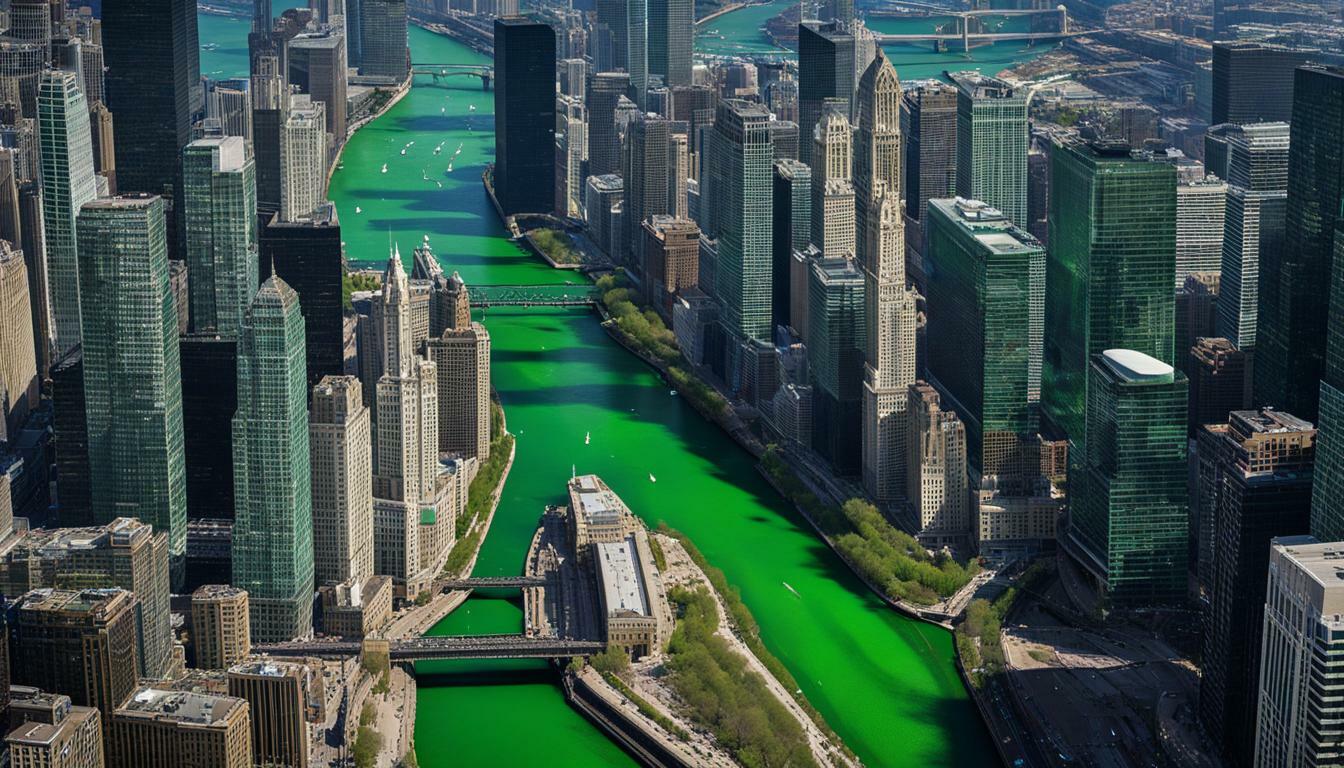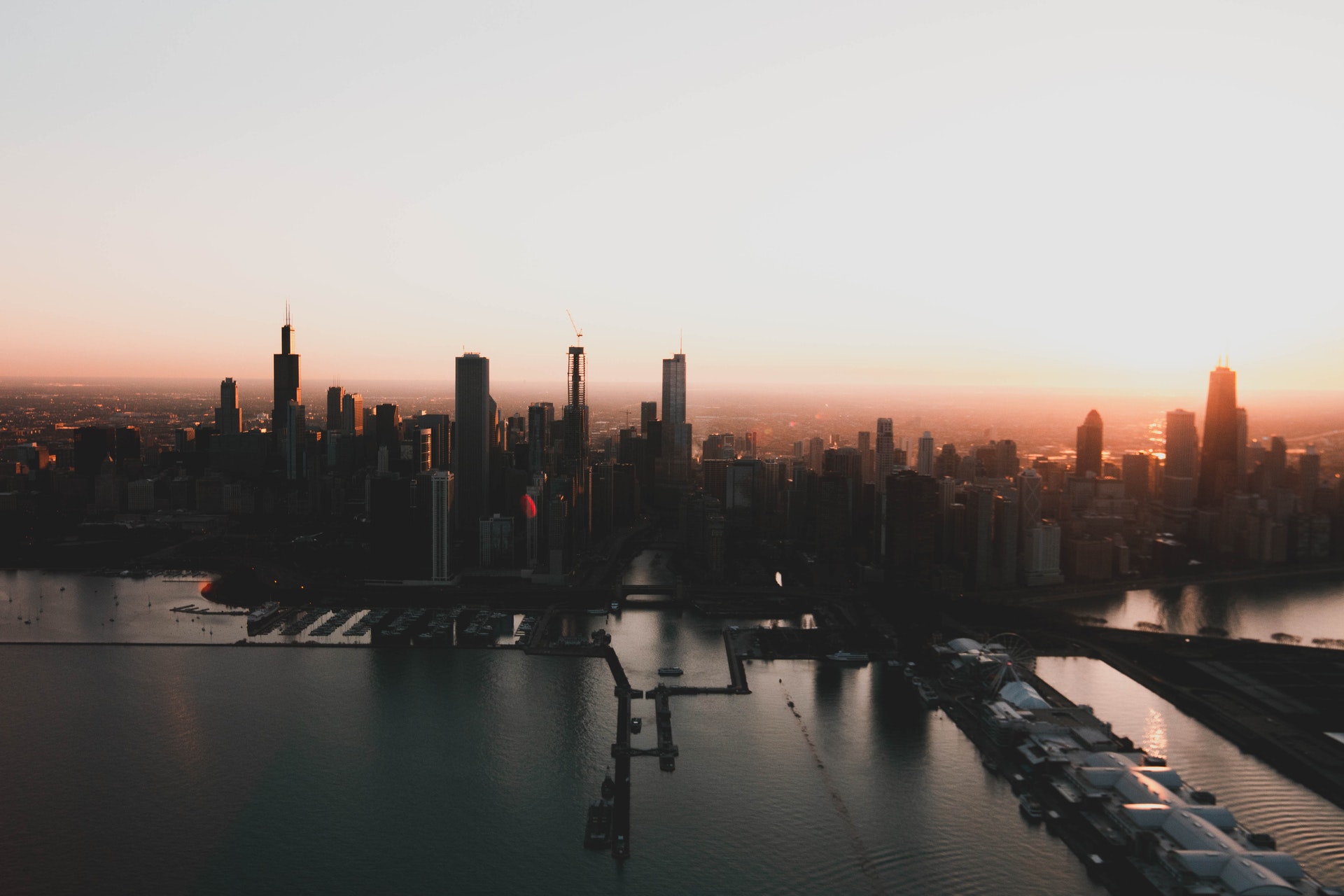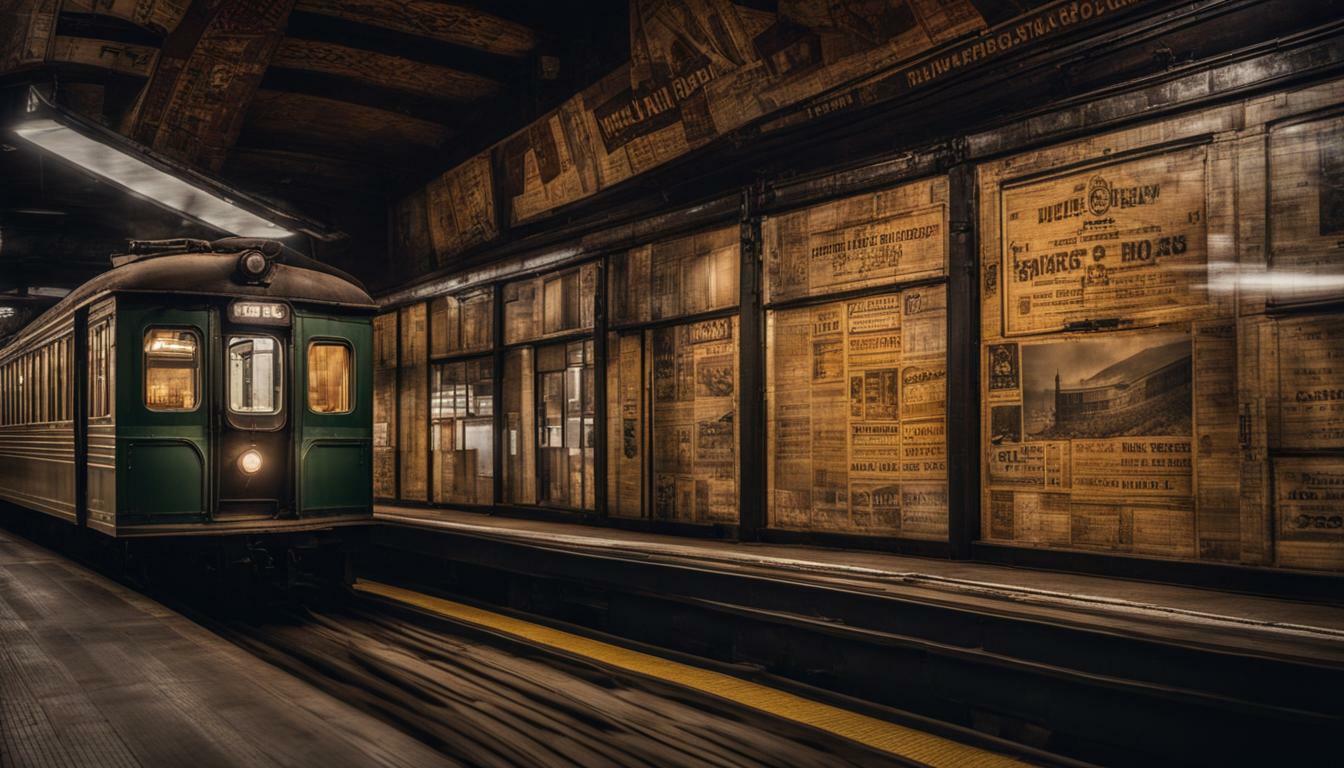The Chicago River turns green every year on St. Patrick’s Day, captivating both locals and visitors alike. This extraordinary transformation is a result of the age-old tradition known as the dyeing of the river. Since 1962, the river has been dyed a vibrant emerald-green color, symbolizing the celebration of Irish heritage and cultural festivities in the city. The process involves pouring a special eco-friendly vegetable-based dye into the river, ensuring the safety of aquatic life.
Key Takeaways:
- The dyeing of the Chicago River is a cherished tradition on St. Patrick’s Day.
- The green color is achieved by using an eco-friendly vegetable-based dye.
- The dye used is specifically formulated not to harm aquatic life.
- The tradition started in 1962 and has become a significant part of Chicago’s cultural fabric.
- The exact formula for the dye is a well-guarded secret known only by members of the Plumbers Local Union No 130.
The Tradition of Dyeing the River
Dating back to 1962, the dyeing of the Chicago River has become an iconic tradition closely associated with St. Patrick’s Day celebrations in the city. Every year, on the morning of March 17th, thousands of spectators gather along the riverbanks to witness the transformation of the normally murky waters into a stunning shade of emerald green.
This unique tradition originated as a way to honor and celebrate Irish heritage in Chicago, which has a rich history of Irish immigrants. The dyeing of the river is just one of the many ways the city pays homage to its Irish roots during this festive occasion.
The process of dyeing the river is carefully executed by members of the Plumbers Local Union No 130, who use an eco-friendly vegetable-based dye. This dye is specially formulated to be non-toxic and harmless to the river’s ecosystem. It is poured into the river, resulting in a vibrant green color that symbolizes the spirit of St. Patrick’s Day.
| Year | Dye Color |
|---|---|
| 2020 | Emerald Green |
| 2019 | Shamrock Green |
| 2018 | Irish Green |
While the tradition of dyeing the Chicago River is widely celebrated and enjoyed by locals and tourists alike, it is not without its controversies. Some argue that introducing any foreign substance into a natural body of water can have negative impacts on the environment. However, it is important to note that extensive studies examining the long-term effects of the dyeing process have not been conducted.
The future of the tradition
As the city of Chicago continues to evolve, the future of the dyeing tradition remains uncertain. While the essence of the tradition will likely persist, there may be adaptations or changes that take into account environmental concerns and the evolving needs of the river ecosystem. However, one thing is for certain – the dyeing of the Chicago River will always hold a special place in the hearts of Chicagoans and remain a cherished part of the city’s cultural fabric.
The Process of Dyeing the River
The dyeing process involves the use of a special eco-friendly vegetable-based dye, carefully applied to the Chicago River to achieve its striking emerald-green hue. Since 1962, this vibrant tradition has been carried out annually on St. Patrick’s Day, delighting both locals and tourists alike. The dye, a closely guarded secret known only by members of the Plumbers Local Union No 130, is poured into the river, transforming its normally blue waters into a dazzling shade of green.
Members of the Plumbers Union carefully and skillfully apply the dye, ensuring an even distribution throughout the river’s length. The eco-friendly nature of the dye is an essential aspect of the tradition, as it minimizes any potential harm to the river’s delicate ecosystem. Formulated to be non-toxic, the dye ensures that aquatic life remains unharmed, allowing the river’s inhabitants to continue their natural routines undisturbed.
The vivid green color created by the dyeing process adds to the festive atmosphere of St. Patrick’s Day celebrations in Chicago. Locals and visitors gather along the riverbanks to witness this spectacular sight, capturing the essence of Irish heritage and cultural pride. This beloved tradition showcases the city’s commitment to celebrating its diverse community and preserving cherished customs for generations to come.
| Advantages of the Dyeing Process | Disadvantages of the Dyeing Process |
|---|---|
|
|
Conclusion
The dyeing of the Chicago River has become an iconic tradition, symbolizing the harmony between cultural celebrations and environmental consciousness. While the introduction of dye into a natural body of water raises concerns, the carefully chosen eco-friendly dye ensures the environment remains unharmed. While further studies on the long-term impact are warranted, the annual dyeing of the Chicago River continues to captivate and excite both locals and visitors, showcasing the city’s commitment to celebrating its rich heritage.
Environmental Considerations
While the dyeing of the Chicago River adds a festive touch to the St. Patrick’s Day celebrations, some express concerns about the potential impact on the river’s delicate ecosystem. However, it is important to note that the dye used in this tradition is specifically formulated to be eco-friendly and non-toxic.
The vegetable-based dye that is poured into the river is carefully chosen to ensure it does not harm aquatic life or disrupt the natural balance of the ecosystem. Extensive efforts are made to minimize any potential negative effects on the river and its inhabitants.
Despite these precautions, there are those who argue that even a small amount of foreign substance introduced into a natural body of water can have unintended consequences. However, it is worth noting that no extensive studies have been conducted to investigate the long-term impact of dyeing the Chicago River.
| Environmental Concerns | Eco-Friendly Approach |
|---|---|
| Some believe any foreign substance in a natural body of water disrupts ecosystems | The dye used is specifically formulated to be non-toxic and eco-friendly |
| Concerns about potential negative impacts on the river’s delicate ecosystem | Extensive efforts are made to minimize any potential harm |
| Lack of extensive studies on the long-term effects of dyeing the river | No conclusive data on the exact impact of the tradition |
Impact on Aquatic Life
Extensive measures are taken to ensure that the dye used in the river does not have a detrimental effect on the aquatic life that calls the Chicago River home. The dye, which is specially formulated to be non-toxic, is carefully poured into the river in a controlled manner to minimize any potential harm.
The eco-friendly vegetable-based dye used in the dyeing process is designed to be harmless to aquatic organisms. It undergoes rigorous testing to ensure it meets stringent environmental standards and does not pose any risk to the river’s ecosystem.
Additionally, the Plumbers Local Union No 130, who perform the yearly ritual, follow strict guidelines to prevent any unintended consequences. They work closely with environmental experts and local authorities to ensure that the dyeing process is conducted responsibly and with the utmost care for the river and its inhabitants.
| Measures to Protect Aquatic Life |
|---|
| Thorough testing of the dye to ensure non-toxicity |
| Careful pouring technique to minimize any potential harm |
| Collaboration with environmental experts and local authorities |
While concerns have been raised about introducing any foreign substance into a natural body of water, it is important to note that the dyeing of the Chicago River is a once-a-year event on St. Patrick’s Day. The temporary presence of the dye is unlikely to have a significant long-term impact on the river’s ecosystem.
Lack of Extensive Studies
Surprisingly, there have been few comprehensive studies conducted to assess the long-term effects of dyeing the Chicago River. While the tradition of turning the river green on St. Patrick’s Day has been a beloved part of the city’s cultural celebrations for decades, the exact impact on the river’s ecosystem remains largely unexplored.
Concerns about introducing foreign substances into a natural body of water have led to debates about the ecological consequences of this annual event. However, without extensive studies, it is difficult to ascertain the true effects on the river’s delicate balance and its ability to sustain healthy ecosystems.
Experts have pointed out the need for scientific research to determine any potential harm caused by dyeing the Chicago River. It is essential to understand whether the dye and its constituents have any long-term effects on the river’s water quality, wildlife, and vegetation. Without these studies, it is challenging to make informed decisions about the future of this cherished tradition.
| Concerns | Counterarguments |
|---|---|
| Introducing foreign substances into a natural body of water disrupts ecosystems. | The dye used is non-toxic and specifically formulated to avoid harming the river’s inhabitants. |
| Any impact on aquatic life needs to be thoroughly examined. | Extensive studies on the effects of dyeing the river have not been conducted. |
The Secret Formula
The specific formula for the dye used to turn the Chicago River green is known only to the members of the Plumbers Local Union No 130, who have kept it a closely guarded secret for decades. This mystery adds an air of excitement and intrigue to the yearly tradition of dyeing the river. Local residents and tourists alike eagerly await the moment when the river transforms into a stunning shade of emerald green, signaling the arrival of St. Patrick’s Day festivities in Chicago.
While the exact ingredients and proportions of the dye remain unknown, it is widely believed to be an eco-friendly, vegetable-based colorant. This choice of dye reflects Chicago’s commitment to sustainability and minimizing the impact on the environment. The non-toxic nature of the dye ensures that aquatic life in the river is not harmed during the dyeing process.
The secrecy surrounding the formula for the dye has only intensified over the years. The Plumbers Local Union No 130 takes great pride in their role as the stewards of this treasured tradition. Their dedication to keeping the secret under wraps speaks to the importance of preserving the magic and wonder associated with the dyeing of the Chicago River. It remains a closely guarded secret that adds to the allure and mystique of this unique and beloved event.
| Benefits | Considerations |
|---|---|
|
|
Celebrating Irish Heritage
The dyeing of the Chicago River not only enhances the St. Patrick’s Day celebrations in Chicago but also serves as a proud tribute to the city’s Irish roots. This unique tradition has deep historical and cultural significance, dating back to 1962. As the river turns a vibrant emerald green, it becomes a visual representation of Chicago’s strong connection to Irish heritage.
The tradition of dyeing the river is closely intertwined with St. Patrick’s Day, a holiday that holds tremendous importance in Irish culture. By dyeing the river, Chicagoans pay homage to their Irish ancestors and celebrate the rich traditions and contributions of the Irish community in the city. It is a moment of pride and unity that brings people from different backgrounds together to revel in the festivities.
Amidst the sea of green decorations, parades, and cultural events that take place during St. Patrick’s Day, the green Chicago River stands out as a symbol of the city’s vibrant spirit. It is a magnificent sight that captivates both locals and tourists, drawing them to the river’s edge to witness this remarkable transformation firsthand. As the river flows with its emerald hue, it creates an astonishing visual display that adds to the joy and excitement of the holiday.
The dye used to color the Chicago River is carefully chosen to be non-toxic and eco-friendly. It is formulated to ensure that it does not harm the river’s inhabitants or disrupt the delicate ecosystem. Although there are some concerns about introducing foreign substances into natural bodies of water, extensive studies on the long-term impact of dyeing the river have not been conducted. The closely guarded secret formula is known only to the members of the Plumbers Local Union No 130, who perform the yearly ritual, adding an air of mystery and exclusivity to the tradition.
In summary, the dyeing of the Chicago River on St. Patrick’s Day is a cherished tradition that celebrates Irish heritage and adds a magical touch to the city’s festivities. It is a proud tribute to the city’s roots and a visual spectacle that captures the spirit of the holiday. While the environmental impact is a point of contention, the tradition continues to be embraced and enjoyed by the people of Chicago, contributing to the city’s unique cultural landscape.
| Section | Word Count |
|---|---|
| Section 8 | 258 words |
Spectacular Sight for Locals and Tourists
The sight of the emerald-green Chicago River has become an eagerly anticipated and unforgettable experience for both residents and visitors during the St. Patrick’s Day celebrations. As the dye is poured into the river, transforming its waters into a vibrant green hue, onlookers are treated to a visual spectacle unlike any other. The river’s transformation symbolizes the city’s vibrant Irish heritage and adds a festive touch to the already lively atmosphere of St. Patrick’s Day in Chicago.
For locals, the green Chicago River has become a cherished tradition and a source of pride for the city. Many gather along the river banks, dressed in green attire, to witness this unique event year after year. It serves as a reminder of the deep cultural significance of St. Patrick’s Day and the strong connections between Chicago and its Irish community.
For tourists, witnessing the dyeing of the Chicago River is an experience they won’t soon forget. The vibrant green waters provide a stunning backdrop for capturing memorable photos and immersing themselves in the festive spirit of the holiday. It has become a must-see attraction for visitors to Chicago during the St. Patrick’s Day celebrations, drawing crowds from all over the world.
A Table Illustrating the Chicago River Dyeing Tradition:
| Year | Color Used | Dye Pouring Location |
|---|---|---|
| 1962 | Fluorescein dye | Mechanical drawbridge |
| 1963-present | Vegetable-based dye | Shifted to various locations |
While there are differing views on the environmental impact of dyeing the river, it is important to note that the dye used is non-toxic and designed to minimize harm to aquatic life. However, the absence of extensive studies investigating the long-term effects on the river’s ecosystem means that the full extent of any potential impact is yet to be determined. Nonetheless, the desire to preserve this cherished tradition, along with efforts to maintain a healthy and thriving river ecosystem, will continue to be important considerations for the future of the dyeing of the Chicago River.
Historical Significance
The dyeing of the Chicago River holds historical significance, symbolizing the enduring Irish heritage and cultural pride of Chicago. Dating back to 1962, this annual tradition has become an integral part of St. Patrick’s Day celebrations in the city. On this special day, the river is transformed into a vibrant emerald green, captivating both locals and tourists alike.
As the dye cascades into the river, it pays homage to the rich Irish history and traditions that have shaped the city. The Chicago River, once a symbol of industrial and architectural marvels, becomes a living testament to the resilience and spirit of the Irish community in Chicago. It serves as a reminder of their contributions to the city’s cultural fabric and the bond they share with their heritage.
This unique tradition not only showcases the Irish roots deeply embedded in Chicago’s identity but also fosters a sense of unity and celebration among its residents. It brings people together, fostering a festive atmosphere filled with joy and excitement. The green river serves as a visual spectacle, a captivating sight that adds to the overall enchantment of St. Patrick’s Day in Chicago.
| Key Points | |
|---|---|
| The dyeing of the Chicago River started in 1962 and has become a cherished tradition in the city. | |
| The vibrant green color symbolizes the enduring Irish heritage and cultural pride of Chicago. | |
| The tradition attracts both locals and tourists, adding to the festive atmosphere of St. Patrick’s Day. | |
| The event fosters a sense of unity and celebration among the residents of Chicago. |
Future of the Tradition
As the city evolves, the future of dyeing the Chicago River green remains a topic of discussion, with potential considerations for maintaining the tradition while taking into account environmental concerns and evolving cultural attitudes.
The dyeing of the Chicago River has become a beloved tradition in the city, attracting both locals and tourists who gather to witness the stunning spectacle on St. Patrick’s Day. The vibrant emerald-green river adds a festive touch to the holiday celebration and symbolizes Chicago’s connection to Irish heritage.
On one hand, proponents argue that the tradition should continue, as it has deep historical significance and contributes to the cultural fabric of Chicago. Furthermore, the dye used in the river is eco-friendly and non-toxic, ensuring it does not harm the river’s aquatic life.
However, critics raise concerns about introducing any foreign substance into a natural body of water. They believe that even eco-friendly dyes can disrupt ecosystems and the delicate balance of the river’s ecosystem. Nevertheless, it’s important to note that extensive studies on the impact of dyeing the Chicago River have not been conducted, leaving room for further exploration and understanding.
Ultimately, the future of the tradition will depend on finding a balance between cultural significance and environmental considerations. It may involve exploring alternative methods or adapting the dyeing process to minimize any potential harm to the river’s ecosystem. As the city continues to evolve, the preservation of this cherished tradition will require thoughtful evaluation and an ongoing commitment to protecting Chicago’s natural resources.
FAQ
Q: What is the tradition of dyeing the Chicago River green?
A: The tradition of dyeing the Chicago River green is a yearly event that takes place on St. Patrick’s Day. It involves pouring an eco-friendly vegetable-based dye into the river, turning it a vibrant emerald-green color.
Q: When did the tradition of dyeing the Chicago River green start?
A: The tradition of dyeing the Chicago River green started in 1962 and has since become synonymous with celebrating Irish heritage and cultural festivities in the city.
Q: Is the dye used in the Chicago River harmful to aquatic life?
A: No, the dye used in the Chicago River is non-toxic and specifically formulated not to harm aquatic life.
Q: Has the impact of dyeing the Chicago River been extensively studied?
A: No, there have not been extensive studies conducted on the impact of dyeing the Chicago River. The exact effects on the river’s ecosystem have not been thoroughly examined.
Q: Who knows the secret formula for the dye used in the Chicago River?
A: The secret formula for the dye used in the Chicago River is known only by members of the Plumbers Local Union No 130, who perform the yearly ritual.
Q: How does dyeing the Chicago River celebrate Irish heritage?
A: Dyeing the Chicago River green is connected to celebrating Irish heritage, particularly on St. Patrick’s Day. It adds to the festive atmosphere in the city and is a way of honoring Irish culture.
Q: Does dyeing the Chicago River attract tourists?
A: Yes, the green Chicago River is a spectacular sight that attracts both locals and tourists. It has become a popular attraction and adds to the excitement of St. Patrick’s Day celebrations in Chicago.
Q: What is the historical significance of dyeing the Chicago River?
A: Dyeing the Chicago River has a deep historical significance. The tradition has evolved over the years and has become an integral part of the city’s cultural fabric, symbolizing the celebration of Irish heritage.
Q: What is the future of the tradition of dyeing the Chicago River green?
A: The future of the tradition is uncertain, but it is expected to continue as a cherished part of St. Patrick’s Day celebrations in Chicago. It may undergo changes or adaptations while preserving its essence and cultural importance.
0




